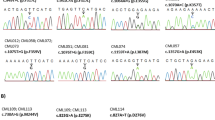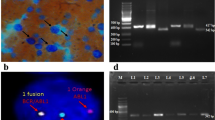Abstract
Mutations in the Bcr-Abl kinase domain (KD) are a major cause for acquired resistance to imatinib (IM) treatment and have been associated with progression and poor prognosis in chronic myeloid leukemia patients. The present study includes 63 patients resistant to standard imatinib dose of 400 mg according to ELN guidelines. Direct sequencing method is used for mutational analysis. The present study revealed 15 exonic mutations in 46.03 % of patients; among them, seven cases (24.13 %) had multiple mutations. Mutations were found to be higher in sokal high- (45.0 %) and intermediate- (68.42 %) compared to low-risk (29.16 %) group. Mutations were observed in 38.09 % of patients with EUTOS (European Treatment and Outcome Study) high risk and in 50.0 % with low risk. The frequency of mutations was 50.0 % in advanced phase, 47.36 % in late chronic-phase, and 43.33 % in chronic-phase patients. 42.10 % of patients with primary resistance and 52.0 % with secondary resistance had mutations. P-loop and T315I mutations were associated with poor survival in advanced phase patients (85.71 %) (P = 0.03). No significant variation was observed with Bcr-Abl transcript levels between the patients with the presence or absence of mutations (P = 0.73). Bcr-Abl levels were found to be significantly elevated in P-loop and T315I mutation carriers (P = 0.001) and also in T315I mutation-positive patients (P = 0.01). P-loop mutations and T315I are frequent in advanced phases and strongly associated with poor prognosis and survival. Hence, the identification of mutations in IM-resistant CML patients will help in treatment optimization with 2nd- or 3rd-generation tyrosine kinase inhibitors (TKIs).





Similar content being viewed by others
References
Faderl S, Talpaz M, Estrov Z, Kantarjian HM. Chronic myelogenous leukemia: biology and therapy. Ann Intern Med. 1999;131(3):207–19.
Alderborn A, Kristofferson A, Hammerling U. Determination of single-nucleotide polymorphisms by real-time pyrophosphate DNA sequencing. Genome Res. 2000;10:1249–58.
Apperley JF. Part I: mechanisms of resistance to imatinib in chronic myeloid leukaemia. Lancet Oncol. 2007;8:1018–29.
Hochhaus A, Kreil S, Corbin AS, La Rosee P, Muller MC, Lahaye T, et al. Molecular and chromosomal mechanisms of resistance to imatinib (STI571) therapy. Leukemia. 2002;16:2190–6.
Donato NJ, Wu JY, Stapley J, et al. Imatinib mesylate resistance through Bcr Abl independence in chronic myeloid leukemia. Cancer Res. 2004;64:672–7.
Duyster J, von Bubnoff N. Resistance to imatinib. In: Cortes J, Deininger M, editors. Chronic myeloid leukemia. New York: Informa Healthcare USA, Inc; 2007. p. 79–94.
Jabbour E, Soverini S. Understanding the role of mutations in therapeutic decision making for chronic myeloid leukemia. Semin Hematol. 2009;46:S22–6.
Hughes T, Deininger M, Hochhaus A, Branford S, Radich J, Kaeda J, et al. Monitoring CML patients responding to treatment with tyrosine kinase inhibitors: review and recommendations for harmonizing current methodology for detecting BCR-ABL transcripts and kinase domain mutations and for expressing results. Blood. 2006;108:28–37.
Branford S, Rudzki Z, Walsh S, Parkinson I, Grigg A, Szer J, et al. Detection of BCR-ABL mutations in patients with CML treated with imatinib is virtually always accompanied by clinical resistance, and mutations in the ATP phosphate-binding loop (P-loop) are associated with a poor prognosis. Blood. 2003;102:276–83.
Corbin AS, Rosee PL, Stoffregen EP, Druker BJ, Deininger MW. Several Bcr-Abl kinase domain mutants associated with imatinib mesylate resistance remain sensitive to imatinib. Blood. 2003;101:4611–4.
Mahon FX, Deininger MW, Schultheis B, et al. Selection and characterization of BCR-ABL positive cell lines with differential sensitivity to the tyrosine kinase inhibitor STI571: diverse mechanisms of resistance. Blood. 2000;96:1070–9.
Redaelli S, Piazza R, Rostagno R, et al. Activity of bosutinib, dasatinib, and nilotinib against 18 imatinib-resistant BCR/ABL mutants. J Clin Oncol. 2009;27:469–71.
de Lavallade H, Khorashad JS, Davis HP, et al. Interferon-alpha or homoharringtonine as salvage treatment for chronic myeloid leukemia patients who acquire the T315I BCR-ABL mutation. Blood. 2007;110:2779–80.
Arocho A, Chen B, Ladanyi M, Pan Q. Validation of the 2-DeltaDeltaCt calculation as an alternate method of data analysis for quantitative PCR of BCR-ABL P210 transcripts. Diagn Mol Pathol. 2006;15:56–61.
Quintas-Cardama A, Cortes J. Molecular biology of bcr-abl1-positive chronic myeloid leukemia. Blood. 2009;113(8):1619–30.
Alikian M, Gerrard G, Subramanian PG, Mudge K, Foskett P, Khorashad JS, et al. BCR-ABL1 kinase domain mutations: methodology and clinical evaluation. Am J Hematol. 2012;87:298–304.
Hughes T, Saglio G, Branford S, Soverini S, Kim DW, Muller MC, et al. Impact of baseline BCR-ABL mutations on response to nilotinib in patients with chronic myeloid leukemia in chronic phase. J Clin Oncol. 2009;27(25):4204–10.
Muller MC, Cortes JE, Kim DW, Druker BJ, Erben P, Pasquini R, et al. Dasatinib treatment of chronic-phase chronic myeloid leukemia: analysis of responses according to preexisting BCR-ABL mutations. Blood. 2009;24:4944–53.
Parker WT, Lawrence RM, Ho M, Irwin DL, Scott HS, Hughes TP, et al. Sensitive detection of BCR-ABL1 mutations in patients with chronic myeloid leukemia after imatinib resistance is predictive of outcome during subsequent therapy. J Clin Oncol. 2011;29:4250–9.
Apperley JF. Part II: management of resistance to imatinib in chronic myeloid leukaemia. Lancet Oncol. 2007;8:1116–28.
Baccarani M, Castagnetti F, Gugliotta G, et al. Response definitions and European Leukemianet Management recommendations. Best Pract Res Clin Haematol. 2009;22:331–41.
Senthil R, Krishanmohan M, Sadasivudu G, Tara R, Rachel TJ, Raghunadharao D. Kinase domain mutations and responses to dose escalation in chronic myeloid leukemia resistant to standard dose Imatinib mesylate. Leuk Lymphoma. 2010;51(1):79–84.
Soverini S, Colarossi S, Gnani A, Rosti G, Castagnetti F, Poerio A, et al. Contribution of ABL kinase domain mutations to imatinib resistance in different subsets of Philadelphia-positive patients: by the GIMEMA Working Party on Chronic Myeloid Leukemia. Clin Cancer Res. 2006;12:7374–9.
Shweta S, Sarjana D. Imatinib mesylate resistance and mutations: an Indian experience. Indian J Med Paediatr Oncol. 2013;34(3):213–20.
Soverini S, Gnani A, Colarossi S, et al. Philadelphia-positive patients who already harbor imatinib-resistant Bcr-Abl kinase domain mutations have a higher likelihood of developing additional mutations associated with resistance to second- or third-line tyrosine kinase inhibitors. Blood. 2009;114:2168–71.
Nicolini FE, Hayette S, Corm S, Bachy E, Bories D, Tulliez M, et al. Clinical outcome of 27 imatinib mesylate-resistant chronic myelogenous leukemia patients harboring a T315I BCR-ABL mutation. Haematologica. 2007;92:1238–41.
Hasford J, Baccarani M, Hoffmann V, Guilhot J, Saussele S, Rosti G, et al. Predicting complete cytogenetic response and subsequent progression free survival in 2060 patients with CML on imatinib treatment: the EUTOS score. Blood. 2011;118:686–92.
Dima D, Trifa AP, Pati M, Vesa CS, Frinc IC, Petrov L, et al. Tyrosine kinase inhibitor treatment outcome in a single center cohort of chronic myeloid leukemia patients. The role of the T315I ABL kinase domain mutation. Rev Rom Med Lab. 2013;21(1/4):29–37.
Bixby D, Talpaz M. Mechanisms of resistance to tyrosine kinase inhibitors in chronic myeloid leukemia and recent therapeutic strategies to overcome resistance. Hematol Am Soc Hematol Educ Program. 2009;461–76.
Kim SH, Kim D, Kim DW, Goh HG, Jang SE, Lee J, et al. Analysis of Bcr-Abl kinase domain mutations in Korean chronic myeloid leukaemia patients: poor clinical outcome of P-loop and T315I mutation is disease phase dependent. Hematol Oncol. 2009;27:190–7.
Gruber FX, Ernst T, Kiselev Y, Hochhaus A, Mikkola I. Detection of drug-resistant clones in chronic myelogenous leukemia patients during dasatinib and nilotinib treatment. Clin Chem. 2010;3:469–73.
Nicolini FE, Ibrahim AR, Soverini S, Martinelli G, Müller MC, Hochhaus A, et al. The BCR-ABLT315I mutation compromises survival in chronic phase chronic myelogenous leukemia patients resistant to tyrosine kinase inhibitors, in a matched pair analysis. Haematologica. 2013. doi:10.3324/haematol.2012.080234.
Mughal TI. Chronic myeloid leukemia: a handbook for hematologists and oncologists. 2013;13:978-1-84214-577-7.
Branford S, Rudzki Z, Parkinson I, Grigg A, Taylor K, et al. Real-time quantitative PCR analysis can be used as a primary screen to identify patients with CML treated with imatinib who have BCR-ABL kinase domain mutations. Blood. 2004;104(9):2926–32.
Press RD, Willis SG, Laudadio J, Mauro MJ, Deninger MW. Determining the rise in BCR-ABL RNA that optimally predicts a kinase domain mutation in patients with chronic myeloid leukemia on imatinib. Blood. 2009;114(13):2598–605.
Elnahass YH, Mahmoud HK, Ali FT, Mohamed MR, Said MM, Samra MAM, et al. Abl kinase domain mutations in imatinib-treated Egyptian patients with chronic myeloid leukemia. J Leuk. 2013;1(1):1000106.
Lange T, Park P, Willis SG, Deininger MWN. BCR-ABL kinase domain mutations in chronic myeloid leukemia. Cell Cycle. 2005;4(12):1761–6.
Ivana H, Margareta RA, Renata Z, Dubravka S, Labar B. Clinical significance of T315I ABL kinase domain mutation detection in patients resistant to imatinib mesylate therapy. Biochem Med. 2010;20(1):75–81.
Acknowledgments
The authors are thankful to the Department of Medical Oncology, NIMS, for supporting this project.
Conflicts of interest
None
Author information
Authors and Affiliations
Corresponding author
Rights and permissions
About this article
Cite this article
Kagita, S., Uppalapati, S., Jiwatani, S. et al. Incidence of Bcr-Abl kinase domain mutations in imatinib refractory chronic myeloid leukemia patients from South India. Tumor Biol. 35, 7187–7193 (2014). https://doi.org/10.1007/s13277-014-1926-9
Received:
Accepted:
Published:
Issue Date:
DOI: https://doi.org/10.1007/s13277-014-1926-9




